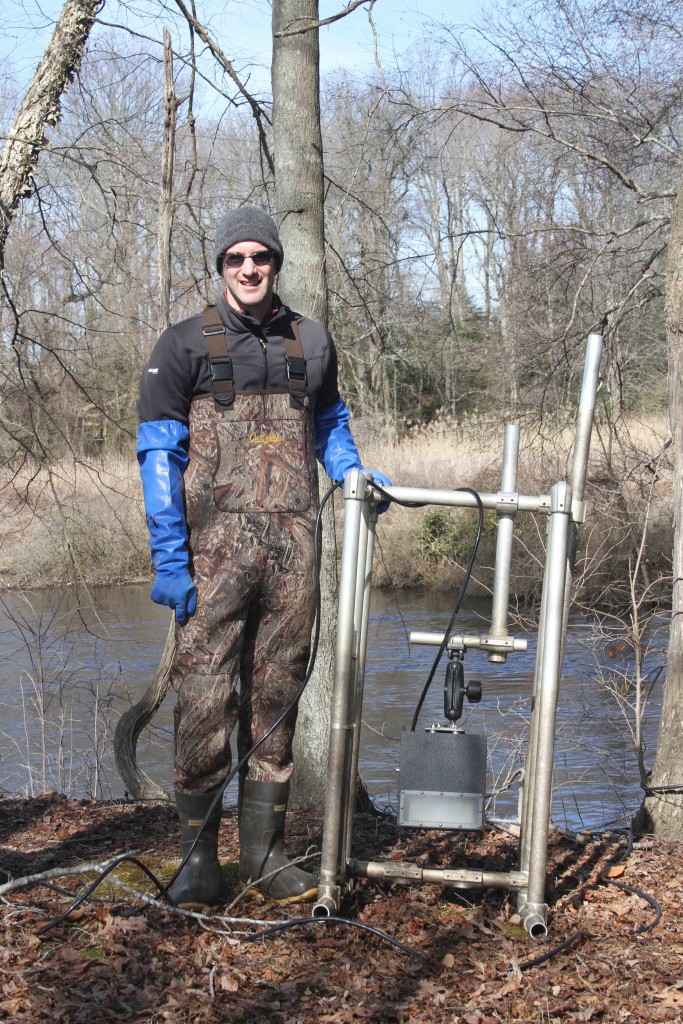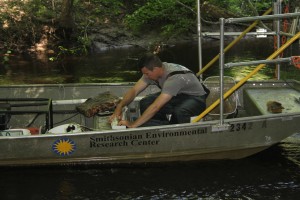by Kristen Minogue
For decades, efforts to conserve Chesapeake river herring have run into a black hole of uncertainty. Managers knew populations had plummeted, but no one knew how many remained. A team of biologists from the Smithsonian Environmental Research Center has found a way forward, recording the first complete spawning run of river herring in the Choptank River since the 1970s.
Their findings, published Tuesday in Transactions of the American Fisheries Society, give conservationists and managers a starting point: 1.3 million adult river herring migrating up the Choptank in one season.

SERC marine biologist Matt Ogburn used DIDSON, an underwater sonar camera, to count river herring in the murky Chesapeake rivers. (SERC)
River herring spend most of their lives in the ocean but migrate into freshwater streams to spawn. They were once among the most abundant fish in the Chesapeake, feeding people and popular fishery species like striped bass. But dams and roads block many from their spawning grounds. Overfishing has further whittled them down—though today, most harvest occurs accidentally, as bycatch in the ocean. By 2012 East Coast states had enacted a coast-wide moratorium, making it illegal to fish river herring in rivers all along the Atlantic, except a few places with enough data to ensure sustainable harvests.
However, since 1989, Chesapeake Bay managers have worked to reopen spawning habitat sometimes obstructed for over a century. They’ve removed dams like the Embrey Dam on Virginia’s Rappahannock River. They’re also working to reduce ocean bycatch. But to know if conservation efforts are working, they need a reliable way to count the fish.

SERC intern Jason Spires measures river herring during an electrofishing run on the Choptank River (SERC)
Aquatic ecologist Matt Ogburn has been testing one idea for three years. Ogburn heads the Fish and Invertebrate Ecology Lab at the Smithsonian Environmental Research Center. The trouble with previous numbers, he said, is that many were based on what fishermen caught—and fishermen usually fish only when numbers are high. The river herring moratoria also mean that since 2011, there aren’t any catch data. To make matters worse, river herring migrations are notoriously sporadic.
“It’s not like all the fish come in and hang out there for a month, and you can count them all and then they all leave,” Ogburn said. “They come in in big pulses, for a day or two or three, and then the numbers go down for a while, and then there’ll be another big pulse.”
With a record that flashy, even weekly sampling could miss something big. “You could choose to sample on Mondays and not get many fish, but if you sampled on Wednesdays, you might get a lot.”
The only way to get a complete picture, Ogburn concluded, was to sample 24/7. In 2013, the lab began fish surveys with an underwater acoustic camera called DIDSON (Dual-Frequency Identification Sonar), a technology Alaska has used for salmon runs. The camera uses sound pulses because many Chesapeake rivers are too murky to detect anything by sight.
In spring 2014, the lab deployed DIDSON on the upper Choptank River, to capture that season’s entire spawning run of river herring. From March through June, DIDSON recorded 10 minutes of footage every hour—almost 350 hours of video the lab combed through afterward. They looked for fish between 200 and 350 millimeters long, the standard size range of adult river herring.
The lab also did weekly electrofishing on the Choptank (running electric currents through the water that stun but don’t harm fish, so scientists can study and return them to the river alive). Electrofishing allowed biologists to estimate the male-female ratio, and the breakdown between the two river herring species (alewives and blueback herring) and other species of similar size.
The sonar footage yielded an estimated 1.3 million river herring migrating up the Choptank, a substantial jump from the figures calculated in the 1972 and 1973 surveys.

The Chesapeake has two species of river herring: Alewife (left) and Blueback Herring (right). (Photo: US Fish & Wildlife Service)
The 1970s methods likely underestimated the population, Ogburn cautioned, because fish could pass over their equipment in high waters. DIDSON may also have overestimated, because individual fish could be counted more than once. So in 2016, the lab started tagging and tracking individual fish to test that possibility.
Diving deeper into the data unearthed more mysteries. Compared to the 1970s, alewife shot up 10-fold, while blueback herring stayed mostly the same. Ogburn admitted he’s curious why. Perhaps fishermen caught more of the larger alewife than smaller blueback herring downstream of the study site before the moratoria. Alewife populations also could have increased, or blueback herring decreased. A more certain change is the sex ratio. River herring runs were more male-dominated in 2014, going from about 45 to 68 percent male (alewives) and 62 to 84 percent male (blueback herring). That could have tremendous implications for conservation, since the number that matters most for reproduction is breeding females.
While this study investigated only the Choptank, the lab has surveyed three other streams. The research offers hope, according to Ogburn, not just because of the 1.3 million fish, but because managers have a base to evaluate how effective their conservation attempts are.
“We’re starting a new count with a new method, and we can track the population from here,” Ogburn said. “We’ll probably never be able to go back and figure out what it was exactly and how these numbers compare to that. But we can start from here and know what happens in the future.”
One day, those plans could even involve reopening the river herring fishery—this time armed with enough data and research to keep it afloat.
Full citation:
Ogburn, Matthew B., Spires, Jason, Aguilar, Robert, Goodison, Michael R, Heggie, Keira, Kinnebrew, Eva, McBurney, William, Richie, Kimberly D., Roberts, Paige M., Hines, Anson H. “Assessment of River Herring Spawning Runs in a Chesapeake Bay Coastal Plain Stream using Imaging Sonar.” Transactions of the American Fisheries Society, http://dx.doi.org/10.1080/00028487.2016.1235612.

